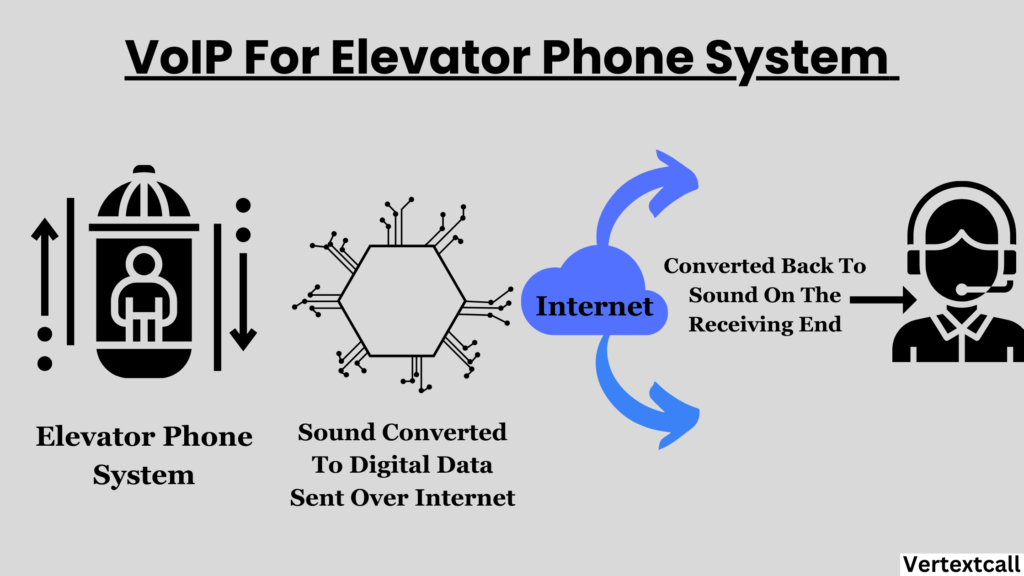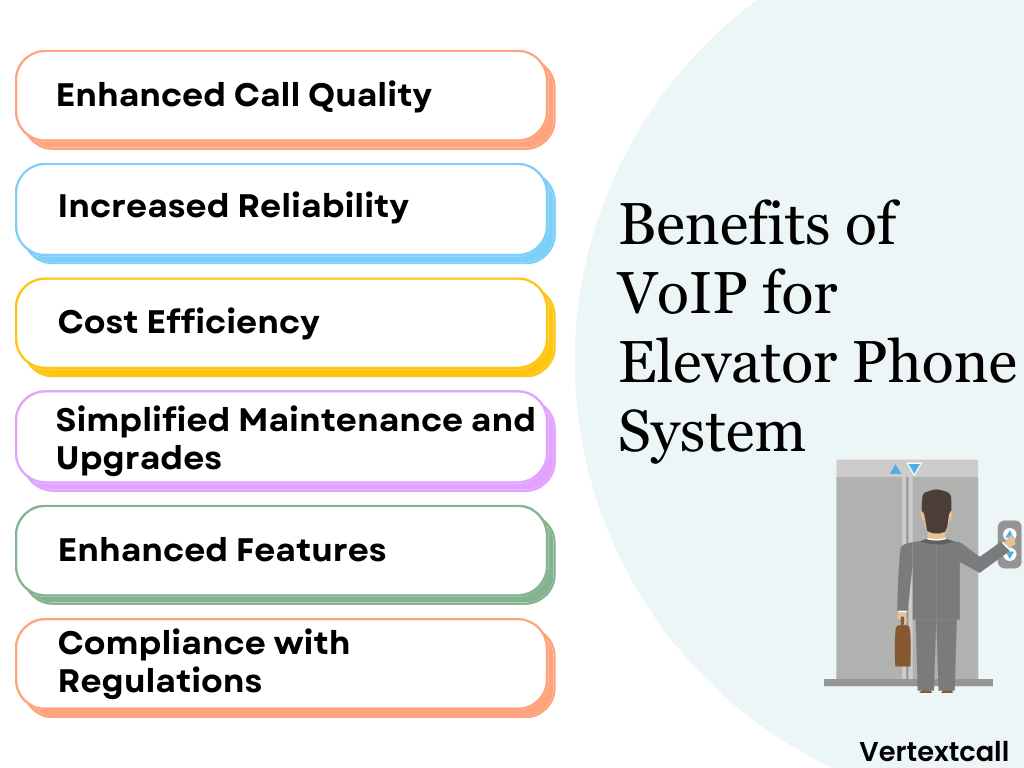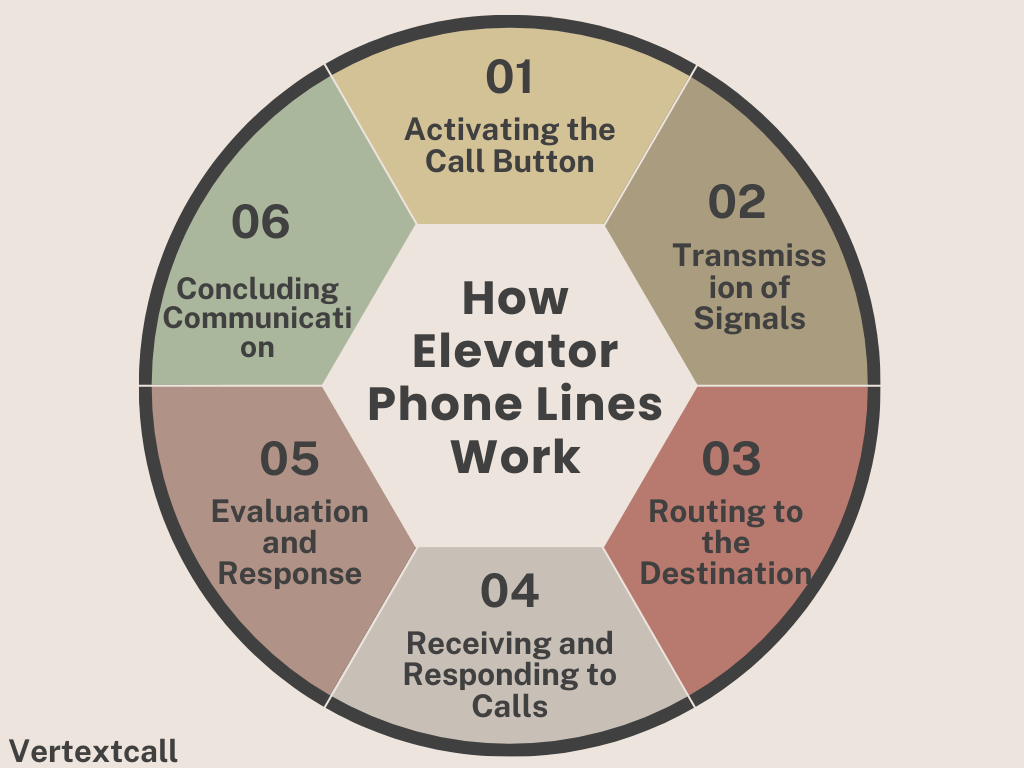Ensuring the safety and functionality of elevator communication systems is more vital than ever. This detailed guide goes into the critical requirements of elevator phone systems, explores the use of VoIP technology, and addresses common questions to help with compliance and enhance emergency response.
Understanding the elevator phone system
Elevator phone systems are vital safety components in tall buildings, offering an immediate communication link during emergencies. Traditionally, these systems used landlines to ensure quick access to help for individuals stuck in elevators.

But with the advancement to Voice over Internet Protocol (VoIP) technology, a shift from analog to digital is enhancing communication efficiency in these crucial systems.
This means that now during an emergency inside an elevator when you press the help button, your call is routed through the internet to reach emergency services or building management.
Benefits of VoIP for elevator phone system
When it comes to elevator phone systems, the integration of VoIP technology brings several key benefits:

1/ Enhanced Call Quality:
Traditional analog phone systems often suffer from poor sound quality, which can be a critical issue during an emergency. VoIP technology, on the other hand, uses digital signals that maintain clarity over long distances, ensuring that your communication is clear with the emergency responders if you are trapped in the elevator.
2/ Increased Reliability:
VoIP significantly enhances the reliability of your elevator phone systems. This enhancement ensures that your calls from elevators have a higher chance of connecting smoothly, even in challenging conditions.
Traditional systems could experience disruptions due to factors such as harsh weather or infrastructure issues, potentially leaving you in a panic without a means of communication.
VoIP effectively addresses these challenges by utilizing the internet, which offers multiple paths for call routing. This redundancy assures that if one connection point fails, your call can still be successfully routed through an alternate path, establishing a more dependable communication channel during emergencies.
3/ Cost Efficiency:
Switching to a VoIP system for elevator communications not only enhances safety and reliability but also presents significant cost savings. VoIP solutions utilize your existing broadband internet connections, eliminating the need for separate phone lines and thereby reducing ongoing operational expenses.
4/ Simplified Maintenance and Upgrades:
VoIP technology simplifies the maintenance and upgrade process for elevator phone systems, as they are digitally managed. This enables remote troubleshooting, and updates, reducing disruptions and ensuring the latest safety and communication features are consistently available.
By optimizing these procedures you can keep your buildings at the advanced safety technology without the logistical challenges of older systems.
5/ Enhanced Features:
Along with the basic function of emergency communication, VoIP elevator phone systems can integrate additional features such as call recording, direct lines to specific departments, and even video calls, providing a more powerful system for emergency response.
6/ Compliance with Regulations:
The integration of VoIP technology into elevator phone systems not only advances communication efficiency and system reliability but also aligns with regulatory requirements.
This compliance is crucial, as governing bodies often require specific standards for emergency communication systems within high buildings to enhance residents’ safety. VoIP systems, with their digital infrastructure, support these regulations by offering clear, reliable, and quick connections to emergency services.
How does an elevator phone line work
Elevator phone lines are a crucial safety feature in modern elevators, providing a direct line of communication for passengers in case of an emergency. Here’s how they typically work:

- Activating the Call Button: When someone in the elevator faces an emergency or problem, they start the communication process by pressing the help or call button inside the cabin.
- Transmission of Signals: Pressing the call button sends a signal through the elevator’s communication system. In traditional setups, this signal travels over analog phone lines, but in VoIP systems, it transforms into digital data packets.
- Routing to the Destination: This signal is then directed to the designated destination, which may include an emergency service center, a 24/7 monitoring center, or the building’s management office. Through VoIP, the digital data packets are channeled over the internet or private networks to reach the destination.
- Receiving and Responding to Calls: The recipient answers the call, enabling voice communication between the elevator occupant and the responder. In VoIP systems, the digital sound quality ensures clear and effective communication, crucial in emergencies.
- Evaluation and Response: The responder evaluates the situation based on the call information provided. Later actions involve sending emergency services or building maintenance staff to address the issue.
- Concluding Communication: Once the problem is resolved or help is in progress, the communication ends, and the call is terminated. The elevator phone system resets, prepared for the next usage.
What are the requirements for an elevator phone?
Ensuring the safety and efficiency of elevator phone systems requires adherence to a set of crucial requirements. These specifications are designed to ensure that individuals have reliable and immediate access to help during emergencies. The foremost requirements include:
1/ Compliance with Standards: Elevator phone systems must comply with various industry standards and regulations, including the Americans with Disabilities Act (ADA) and the National Fire Protection Association (NFPA). These standards ensure the systems are accessible and functional in emergencies, providing clear guidelines for installation, operation, and maintenance.
2/ Direct Connection: The system must establish a direct connection to an emergency telephone line or a 24/7 monitoring service. This ensures that anyone in urgency can reach a responder without delay.
3/ Power Backup: Elevator phone systems require an independent power supply or backup power to remain operational during power outages, ensuring they can always function in emergencies.
4/ Hands-free Operation: To accommodate users in crisis, perhaps unable to operate the phone manually, systems must feature hands-free operation. This allows for immediate communication upon activation of the call button without the need for further physical interaction.
5/ Regular Testing and Maintenance: Regular testing is necessary to ensure the system’s reliability and functionality. Maintenance protocols must be established to address any identified issues immediately, keeping the system in optimal working condition.
6/ Clear Audio: The system must support clear and understandable audio communication. Voices need to be loud and clear enough to be understood under various conditions, including in noise-filled environments.
7/ Location Identification: An essential feature is the ability of the system to automatically transmit the elevator’s location within the building to the emergency responder. This ensures immediate action can be taken, particularly in large or complex structures.
FAQ’s
Q1) Can you use VoIP for elevator phones?
Ans: Yes, VoIP can be used for elevator phone systems. This advanced technology enhances communication efficiency, supports regulatory compliance, and offers superior reliability in emergencies.
Q2) What type of phone line is needed for an elevator?
Ans: Elevator phones traditionally require analog phone lines to operate. However, with advancements in technology, VoIP phone lines have become a preferred option due to their digital efficiency and the ability to integrate with modern building communication systems.
Q3) Can the elevator phone line be cellular?
Ans: Yes, elevator phone lines can indeed be cellular. This is particularly valuable in scenarios where traditional wired connections are not feasible or where wireless solutions offer a more reliable or cost-effective alternative.
Cellular elevator phone systems utilize GSM or CDMA networks to establish direct communication links to emergency services or monitoring centers. This approach is increasingly popular due to its flexibility, ease of installation, and the extensive availability of cellular networks.
Q4) What kind of phone works with VoIP?
Ans: VoIP (Voice over Internet Protocol) systems are adaptable, supporting a wide range of telephony hardware. This includes traditional analog phones, which can work with VoIP using an Analog Telephone Adapter (ATA) that converts analog signals to digital data.
IP phones, specifically designed for VoIP, connect directly to your internet router or switch and provide superior call quality and functionality. Additionally, software-based phones or softphones can be installed on computers and mobile devices, allowing users to make calls via a user interface without the need for physical telephony hardware.
Q5) Can you use an ATA with an elevator?
Ans: Yes, you can use an Analog Telephone Adapter (ATA) with an elevator. An ATA device enables the connection of a traditional analog phone device to a digital or VoIP network. This can be especially useful in transitioning elevator phone systems from POTS lines to VoIP technology.
Using an ATA allows the existing analog elevator phone to communicate over the internet or a private digital network, combining the reliability of traditional systems with the enhanced capabilities and compliance of VoIP solutions.
Q6) Is the POTS line required for the elevator?
Ans: No, a Plain Old Telephone Service (POTS) line is not strictly required for an elevator phone. Many buildings now utilize Voice over Internet Protocol (VoIP) systems, which do not rely on traditional POTS lines.
These systems can offer clearer, more reliable communication through digital networks. However, it is important to ensure that any alternative to a POTS line meets all regulatory requirements and provides similar reliability and accessibility, particularly in emergencies.
Related Reading: POTS line vs VoIP

